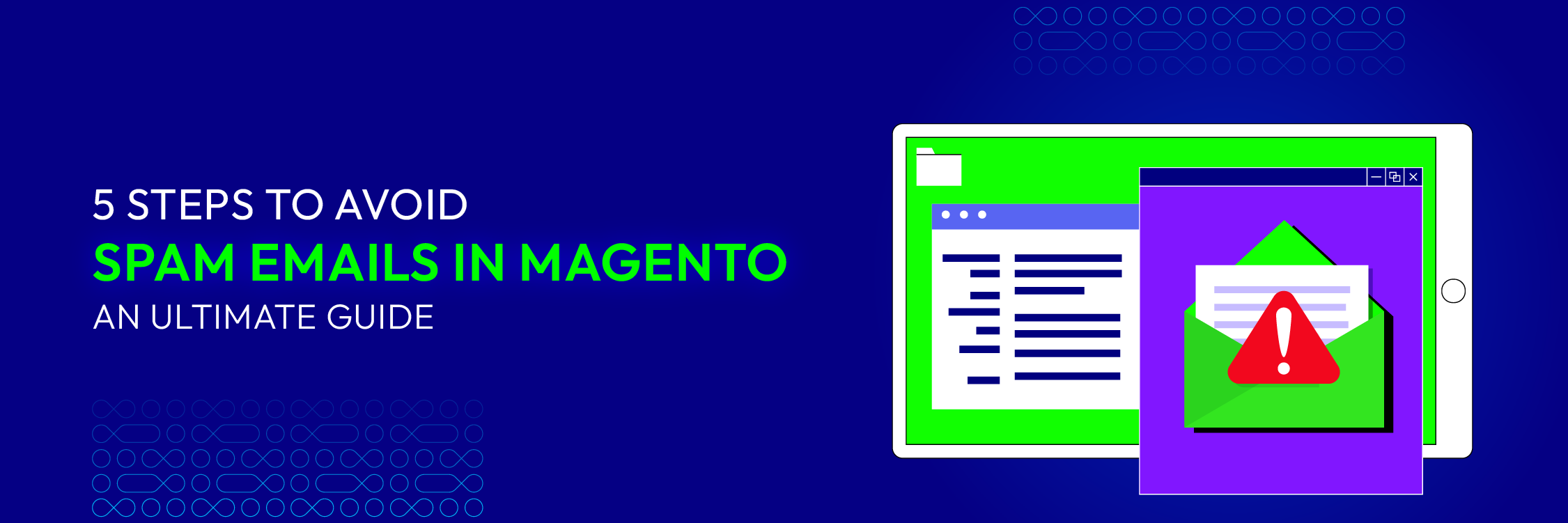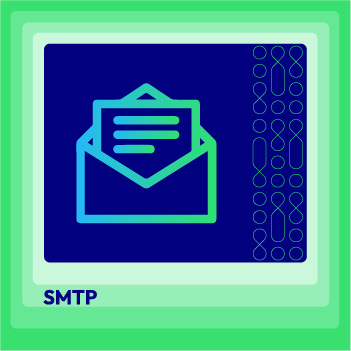5 Steps to Avoid Spam Emails in Magento: An Ultimate Guide
Vinh Jacker | 03-17-2025

Emails might seem like a traditional marketing tool, but they remain effective for decades. However, if your emails consistently end up in the spam folder, you might doubt their value.
In a Magento store, sending emails is a regular task to keep customers informed about their order status, product delivery, and more. If your emails keep landing in the spam folder, it can be incredibly frustrating. Understanding the reasons behind this and taking appropriate action is crucial.
In this blog, we will explain why emails end up in spam and how to prevent it. Discover practical tips for ensuring your emails in Magento reach the inbox, enhancing deliverability and visibility.
Understanding Spam Filters in Magento
First, let’s briefly explain what a spam filter is and how it works. A spam filter is a type of algorithm that identifies and blocks unwanted or harmful emails from attackers or marketers. These emails, known as spam, can clutter your inbox, take up space, and hide important messages. Spam filters help protect users from these unwanted messages, data theft, and email-based cyber-attacks.

Spam filters are essential for email service providers (ESPs) to ensure that only relevant emails reach the primary inbox. In Magento, emails are filtered based on certain criteria that influence their rating, ultimately determining if they are classified as spam. Here are some common factors that determine spam:
Content Filters
These filters analyze the text in an email to check for spammy words or phrases, such as those related to deals, explicit content, or emotional manipulation. To avoid being flagged as spam in Magento, avoid words related to money like “discount,” “limited time,” or “offer,” and inappropriate language.
Blacklist Filters
Spam filters maintain lists of blacklisted domains and IP addresses, blocking emails from these sources. This list is regularly updated as spammers frequently change their email addresses. Conversely, whitelisted domains are trusted and allowed through.
Language Filters
Emails written in a language different from what the user typically uses may be flagged as spam.
Header Filters
These filters examine the email header to detect illegitimate sources or falsified information, such as the number of recipients, inconsistencies in the SMTP transaction, and the legitimacy of the email domain and IP address.
Machine Learning
Spam filters use machine learning to classify emails by analyzing word patterns and probabilities. If the percentage of suspicious words is high, the email is marked as spam. Machine learning can achieve up to 98% accuracy and can learn new spam indicators over time.
Rule-based Filters
These filters let users set specific rules for incoming emails. Emails containing certain words, senders, or phrases from a “banned list” are automatically sent to the spam folder. However, emails not matching these rules might still get through.
By understanding these different filtering methods, users can better manage and reduce spam in their inboxes.
Steps to Avoid Spam Emails in Magento 2
Step 1: Maintain a Clean Domain Reputation
First and foremost, building a clean domain reputation is essential for convincing spam filters and ESPs of your authenticity, which in turn improves email delivery. Here’s how to establish a good domain reputation:
Comply with the CAN-SPAM Act
When sending emails through Magento, you must adhere to the rules and regulations set by the CAN-SPAM Act. This law ensures that email-sending activities remain ethical. To ensure your emails reach recipients’ inboxes, remember to:
- Avoid false or misleading information.
- Clearly label the message as an ad.
- Include the sender’s location.
- Respect recipients’ requests to opt out of future emails.
- Monitor how others represent your brand.
Use an Established Domain
If you’re using a new domain, opting for an established one can be beneficial. A domain with stability and longevity can enhance your reputation and increase the chances of your emails landing in the primary inbox.
Let’s take an example of how to set up a domain correctly:
✅ Correct: [email protected]
❌ Incorrect: [email protected]
Limit Emails Per Domain
The amount of emails you can send is limited by email service providers. Make sure your email campaigns adhere to these restrictions, as going over them could damage the reputation of your site.
Use Exclusive Domains for Specific Activities
Creating separate domains for different functions can help personalize your activities, streamline your workflow, and manage queries effectively, all while building a solid reputation over time. For example, having distinct domains for customer service, general information, and partnerships can prevent confusion and improve email domain management.
Step 2: Configure Servers and IPs

Use a Dedicated IP Address
Ensure you use a dedicated IP address instead of a shared one. Shared IPs can expose your email reputation to the risks of spammers using the same IP. A dedicated IP helps protect your email deliverability and optimizes your Magento conversion rates by avoiding the risk of being blocked due to others’ actions.
Configure Email Authentication: SPF, DKIM, and DMARC
- SPF (Sender Policy Framework): This layer verifies that emails from your domain are sent from your IP address, preventing spoofing.
- DKIM (DomainKeys Identified Mail): This involves a private key, public key, and signature in the domain’s DNS record to verify the sender’s authenticity.
- DMARC (Domain-based Message Authentication, Reporting & Conformance): This protocol often implemented by a top DMARC provider, executed with SPF and DMARC records, ensures emails are delivered to the primary inbox. SPF checks the sending IP’s authority to send emails for the domain, while DKIM uses cryptographic signatures to verify the message content’s integrity.
Utilize an SMTP Server
You can send emails on Magento using the Simple Mail Transfer Protocol (SMTP) by using a particular third-party SMTP service. With services like Gmail, Amazon, Microsoft, or any other mail server account, this makes it simple to send emails from one server to another.
With your server configured, you can move to the next step.
Step 3: Build Effective Email Structures for Magento Emails
Below is the recommended Email Structure to Avoid Spam in Magento.
Include a Plain Text Part
Magento typically sends only the HTML part of emails, which can increase the spam score. To improve compatibility and accessibility, manually create text parts for each email template or automatically generate them from the HTML version.
Adjust Quote-Printable Line Length
The standard quote-printable line length should be up to 998 characters to comply with the RDC 2822 specification and enhance readability. Magento’s default line length for print-quotable content is 200 characters, but you can adjust this value as needed.
Embed Images
Emails without images are more likely to be classified as spam. Enhance your email security by including at least one image in your message. However, avoid using images from external sources.
Use Valid HTML Structure

Work with an experienced HTML developer to ensure your email body has a well-structured HTML layout. Stick to simple HTML and tables, avoiding complex CSS3.
These are the main guidelines for formatting emails. Next, let’s move on to how to optimize your email content to avoid spam in Magento.
Step 4: Optimize Email Content for Magento
Valuable Text
Make sure the content in your emails is something your readers would actually find interesting. First, divide up your audience into several groups, then target each group with communications that are pertinent to them.
Avoid Spam Trigger Words
Terms like “discount,” “free,” and “buy now” frequently cause spam. They may draw attention, but they also make it more likely that your emails will be regarded as spam. Instead, take a customized strategy to ensure that your information is understandable and relatable.
Avoid Link Shorteners
While shortened links look cleaner, they can undermine trust and increase the chances of your emails being marked as spam. Use full, descriptive URLs to maintain transparency and authenticity with your recipients.
Use High-Resolution and Relevant Images
Include images in your emails to add value, but avoid using just one image or too many images. A single image can be seen as spam, and too many can dilute your message. Add a moderate number of high-resolution, relevant images to enhance your content.
Step 5: Test Email Messages
Use Third-Party Services
Before sending emails, it’s crucial to test them. Third-party services can help you evaluate the email’s spam score and provide previews on various platforms and devices. They also offer suggestions for improving your email’s HTML coding.
Review With Your Team
After creating an email in Magento, send it to your staff and teammates for feedback. Use their input to refine and enhance the quality and effectiveness of your email content.
Ensure Mobile Compatibility
Magento’s flexible design is crucial for reaching a wider audience, especially considering the significance of smartphones. Make sure your emails work well on mobile devices by testing them there.
Additional Tips to Avoid Spam Emails in Magento
Segment the Email Recipients
Send emails only to recipients who have specifically requested to receive them. Sending unsolicited emails can harm the reputation of your domain, and you run the danger of being blacklisted if several receivers report your emails as spam.
Avoid Mass Email Purchases
Buying email lists is not advisable, as you cannot verify the authenticity of the addresses. A high volume of unverified and fake emails can harm your deliverability and increase your bounce rate.
Respond to Grievances and Unsubscribes
To avoid spam emails in Magento 2, Include an unsubscribe option in your emails, preferably in the footer, to make it easy for recipients to opt out. This helps you comply with the CAN-SPAM Act and maintains a good sender reputation.
Use CAPTCHA to Prevent Spam
Install CAPTCHA on your Magento 2 store to prevent spam bot registrations. This security measure requires users to complete simple tasks to prove they are human, not bots, enhancing the overall security of your site.
Tools for No-Spam Email in Magento 2
Magento 2 SMTP
Mageplaza’s Magento 2 SMTP extension helps improve your email reputation, which is essential for every email marketing campaign. Say goodbye to the spam folder! With easily configurable ports and hosts, concise modules, and user guidelines provided below the fields, this extension is a valuable tool for any online store.
MailGun
With MailGun , you can use the plugin to make sending, receiving, and tracking emails straightforward. To ensure your emails avoid spam folders, configure the Magento dashboard to monitor who opens and clicks on them. This helps optimize deliverability and engagement with your email campaigns.
Read more: How to configure Mailgun SMTP in Magento 2
FAQs
1. How can I make sure emails from my Magento store aren’t tagged as spam?
Ensure that your server is configured correctly to prevent spam folders and send emails from your domain. To foster trust, keep up a good sender reputation, adhere to email authentication methods like SPF and DKIM, and think about employing a dedicated IP address.
2. For greater deliverability, is it preferable to integrate graphics in Magento emails?
It is advised to directly incorporate photos into your emails. When opposed to employing external image links, this method lowers the likelihood of spam classification. Make sure the HTML in your emails is organized properly and adheres to best practices for content.
3. What aspects of sending transactional or order status emails in Magento should I take into account to avoid spam?
When sending transactional emails, take into account things like using SPF and DKIM for authentication, conducting content analysis to remove phrases that could be construed as spam, and making sure your email server is configured correctly. By taking these precautions, emails are more deliverable and less likely to be regarded as spam.
4. Will using shortened links in my Magento emails impact email deliverability, or should I avoid doing so?
Shorter URLs should not be included in emails. Including complete, informative links promotes transparency and genuineness and allays worries that emails can be mistaken for spam.
5. In order to stop spam emails in Magento 2, how can store owners use email protection measures?
Owners of Magento stores can incorporate strategies for spam prevention and reputation building, such as adopting Magento CAPTCHA. OTP verification further increases security, while testing and validating email addresses on a regular basis lowers bounce rates.
6. Is it possible to enhance email delivery and prevent spam with a Magento extension?
Yes, by guaranteeing proper server configuration and providing email segmentation options, a Magento plugin can improve email deliverability. Supporting authentication standards like DKIM, DMARC, and SPF also lessens the possibility that emails will be categorized as spam.
7. How can I prevent email services from labeling my Magento mailings as spam?
Make sure your Magento mails are compliant with the CAN-SPAM Act by adding a simple unsubscribe button and informative content. Test newsletters frequently with third-party services to evaluate their cross-platform compatibility and spam ratings.
Conclusion
To understand how to prevent sending spam emails in Magento 2, it’s crucial for store owners to implement proactive strategies. This ensures that important emails like order confirmations consistently reach recipients’ inboxes, preserving a positive email reputation.
This article delves into the mechanics of spam filters in Magento, highlighting the importance of configuring servers and IPs for effective email delivery. It also outlines best practices aimed at minimizing the occurrence of sending and receiving spam emails within the Magento ecosystem.







